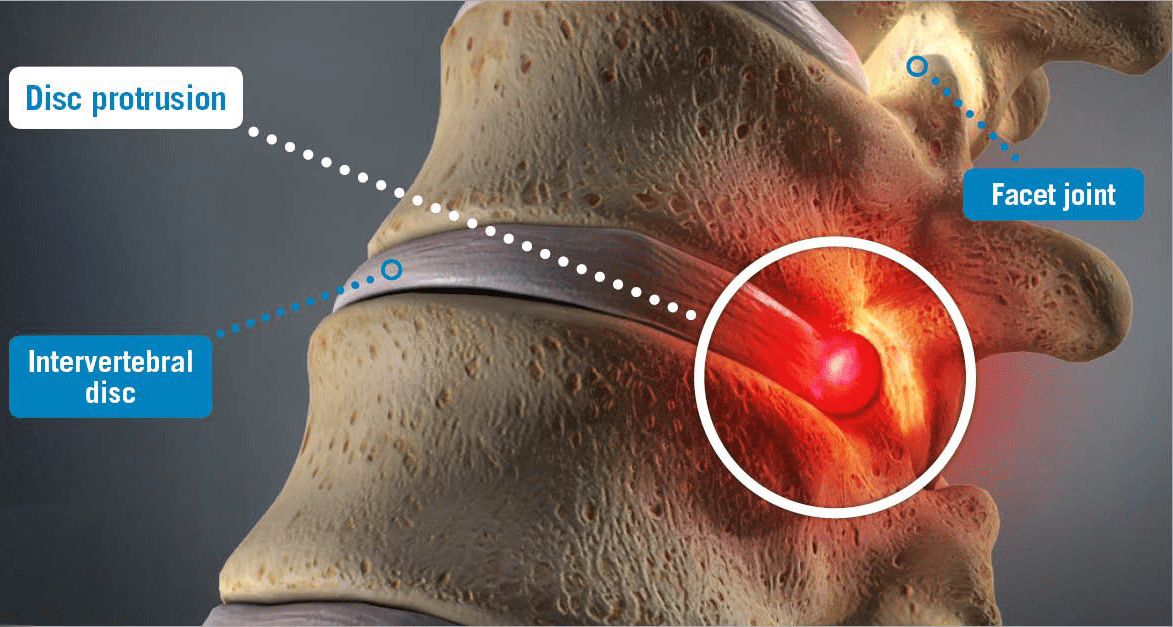- Conditions
- Procedures
- Patient care
- Why choose us
- Our Doctors
- Contact
Home » Spine Conditions »
What is disc protrusion?

Disc protrusion is a common form of spinal disc deterioration that can cause neck and back pain. Changes occurring with the regular aging process are responsible for disc deteriorations, although an injury might speed up the degenerative process. However, a protruding disc may go undetected unless it encroaches upon a nearby nerve.
When functioning correctly, the spinal vertebrae are cushioned by pliable, oval-shaped discs that essentially act as shock absorbers for the neck and back. Over time, however, discs deteriorate and might bulge beyond their normal anatomical positions in the spinal column. Learn about a disc protrusion diagnosis, symptoms and treatment options in the following article.
The stages of disc protrusion
With age, all body parts change, including the components of the spine. Discs dehydrate and lose elasticity. This weakens the disc and makes it more vulnerable to the following stages:
- The first stage following natural weakening may be classified as a disc protrusion when the disc’s core (contained within the disc’s tough outer wall) has begun pushing into the spinal column. Disc protrusions may involve 180 degrees or less of the disc’s circumference.
- The second stage of disc deterioration often consists of a bulging disc, when the disc’s inner core moves farther around the disc circumference beyond its normal parameters as it pushes into the disc’s outer layer, called the annulus fibrosus, creating a bulge. A bulging disc is said to involve more than half (more than 180 degrees) of the disc’s circumference.
- The third stage is the final stage may be a herniated disc, which means the disc’s outer wall finally tears, allowing the inner gel-like material to escape containment by the outer wall.
It is important to remember that different health care providers may use terms like bulging disc, disc protrusion and herniated disc interchangeably, so you may want to ask for clarification if these terms are discussed during your diagnosis. Also, keep in mind that a disc with a bulge in the outer wall will not always lead to a herniation, or tear, in the disc wall. Disc bulges and tears are often unrelated.
Disc protrusion symptoms
The spinal canal is home to the spinal cord and dozens of nerve roots that branch off the spinal cord, exit the spine and continue to the bodily areas they serve. When a disc protrudes into the limited space of the spinal canal, the disc might place compressive pressure, irritate or otherwise interfere with a nerve root or the spinal cord. It is this nerve compression that causes the most serious disc protrusion symptoms, including:
- Local, chronic neck and back pain
- Pain, numbness and tingling in the extremities
- Sciatica
- Loss of flexibility or mobility
- Stiffness or soreness
- Muscle weakness
The specific symptoms caused by a disc protrusion will depend on the location of the problem, as well as the extent of the disc degeneration. Without question, the two most common areas of the spine to develop disc degeneration are the cervical spine (in the neck) and the lumbar spine (in the lower back). That’s because these two regions are both highly flexible and also support significant body weight.
When a disc bulges in the neck it can cause localized neck pain, but if a nerve root is pinched, symptoms can extend throughout the upper body, including the shoulders, arms and fingers. If the spinal cord is compressed by a disc protrusion in the cervical spine, it can lead to spinal cord dysfunction that causes the patient to experience heaviness in the arms and legs, difficulty walking and the deterioration of fine motor skills in the hands.
Alternatively, a protruding disc in the lower back that compresses a lumbar nerve root or the sciatic nerve may cause lower back pain as well as numbness, tingling, sharp pain and muscle weakness in the legs, feet and buttocks.
Diagnosis and treatment of protruding discs
Correctly diagnosing a disc protrusion typically requires the use of medical imagery, a detailed medical history and a thorough examination by a physician. Conservative disc protrusion treatment methods are often quite effective and typically include massage, bedrest, physical therapy and pain medications. Spine surgery is only considered when conservative treatment of the disorder has proven ineffective after several months or a patient’s symptoms are extreme and debilitating.
If you’re suffering from a disc protrusion and nonsurgical conservative treatment has failed, contact USA Spine Care. We treat disc protrusion with minimally invasive procedures that incorporate the latest technology. USA Spine Care’s outpatient surgeries designed to relieve symptoms without the extended recovery and rehabilitation periods associated with traditional open back surgery.^
As the leader in minimally invasive spine surgery, the outpatient procedures performed at USA Spine Care have helped more than 75,000 patients find relief from their chronic neck or back conditions. Our techniques are muscle-sparing and use a less than 1-inch incision to provide a safer and effective alternative to traditional open neck or back surgery.^
To learn more about disc protrusion and the procedures performed at our state-of-the-art facilities, reach out to USA Spine Care today. We are pleased to offer a no-cost MRI review* to determine if you are a potential candidate for our minimally invasive spine surgery.
